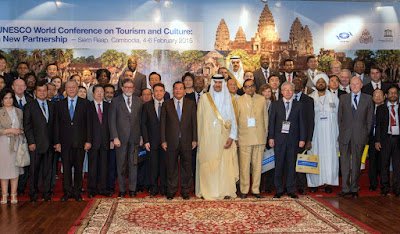Cambodia Culture in Management
The globalization sweeping the world
has opened many national markets for international business. Global private
investment in most part is now mad by Multinational Corporation clearly these
corporations play a major role in the world trade because of their demonstrated
management skills, technology. Recently developments in global market are
indicative of the rapidly growing international business. Exactly, to our
business and corporation get well it du to good communication and understand
characteristic of organization. As for culture in management it as not
different as run business
Culture is term used by social scientists for away of
life. Every human society has a culture. Culture includes a society’s arts,
beliefs, institution, inventions, language, technology, and values. A culture
produces similar behavior and thought among most people in a particular
society. To learn about a culture, one may ask such question as these: What
language do the people speak? What do the people of the society wear? How do
they govern themselves? How do they judge right from wrong?
People are not born with any knowledge of a culture.
They generally learn a culture by growing up in a particular society. They
learn mainly through the use of language, especially by talking and listening
to other members of the society. They also learn by watching and imitating
various behaviors in the society. The process by which
 |
| Cambodia Culture |
Culture and society. Some societies such as those of
Tibetans in Tibet and various people of the Pacific Islands have traditionally
been associated with a single culture. Other societies such as those of the
United States and Canada are multicultural societies. They include many
distinct cultures. People of one culture who move to a country where another
culture dominates may give up their old ways and become part of the dominant
culture. The process by which they do this is called assimilation. Through
assimilation, a minority group
eventually disappears because its member lose the cultural characteristics
that set them apart in a multicultural society, however, assimilation does not
always occur.
Every culture change. But all parts of a culture do
not change at the same time. For example , science and technology may sometimes
change so rapidly hat they lessen the importance of customs, ideas, and other
nonmaterial parts of a culture. At other times, changes in ideas and social
systems may occur before changes in technology. The failure of certain parts of
a culture to keep up with other, related parts is referred to as cultural lag.
A number of factors may cause a culture to change. The two main ones are(1)
contact with other cultures and (2) invention.
Contact with other culture. No society is so isolated
that it does not come in ones are(1) contact with other societies. when contact
occurs, societies borrow cultural traits from one another. As a result,
cultural traits and patterns tend to spread from the society in which they in
what is now Mexico thousand of years ago and eventually spread throughout the
world.
Diffusion can occur without firsthand contact between
cultures. Products or patterns may move from group A to group C through group B
without any contact between group A and group C. To day, diffusion is rapid and
widespread because many culture of the world are linked through advanced means
of transportation and communication and communication.
When two cultures have continuous, firsthand contact
with each other, the exchange of cultural traits is called acculturation.
Acculturation has often occurred when one culture has colonized or conquered
another or as a result of trade. In addition to adopting each other’s traits,
the two cultures may blend traits. For example, if the people of the cultures
speak different languages, they may develop a mixed language called pidgin in order
to communicate. The cultures may also exchange or blend such traits as
clothing, dances, music, recipes, and tools. Through acculturation, parts of
the culture of one or both groups change, but the groups remain distinct. In
this way, acculturation differs from assimilation. Through assimilation, one
group becomes part of another group and loses its separate identity.
Inventions have led to many changes in a culture. The
invention of agriculture, for example, made it possible for people to settle in
farm villages. Their values and social organization changed. They placed
importance on using land and animals to produce crops. They began to build
permanent housing. They developed systems of irrigation and a number of tools
Including I think that culture it is very important
for business management, daily living and people over the world because culture
make people know about characteristics of and changing of each culture. Moreover,
know about globalization, diversity in the work and knowledge of cultural for
managers working in all function.
Cambodia Culture in Management
 Reviewed by khmerkhasikor
on
8:51 AM
Rating:
Reviewed by khmerkhasikor
on
8:51 AM
Rating:
 Reviewed by khmerkhasikor
on
8:51 AM
Rating:
Reviewed by khmerkhasikor
on
8:51 AM
Rating:









No comments:
Post a Comment